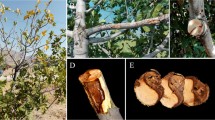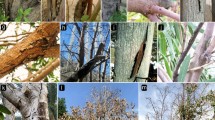Abstract
Canker and decline of Araucaria heterophylla (Norfolk Island pine) trees were observed during surveys conducted in the costal suburbs of Perth in 2009 and 2010. Samples from symptomatic and asymptomatic parts of trees were collected and morphological characteristics of the consistently isolated fungus analysed. The isolated fungus was identified as Neofusicoccum parvum using phylogenetic analysis of combined sequence data from the internal transcribed spacer of the rDNA (ITS), the translation elongation factor 1α, β-tubulin and RNA polymerase subunit II. N. parvum isolates were pathogenic when inoculated on excised branches of Norfolk Island pine. This species has been recorded on A. heterophylla in New Zealand, but this is the first report of this species causing decline and cankers of Norfolk Island pine in Australia and worldwide.





Similar content being viewed by others
References
Anonomyous (2007) Norfolk Island pine dieback, Scion. Available at www.nzffa.org.nz/images/design/ Norfolk- pine-dieback (Last accessed 5 January 2011)
Begoude BAD, Slippers B, Wingfield MJ, Roux J (2010) Botryosphaeriaceae associated with Terminalia catappa in Cameroon, South Africa and Madagascar. Mycol Prog 9:101–123
Burgess TI, Wingfield MJ (2002) Quarantine is important in restricting the spread of exotic seed-borne tree pathogens in the southern hemisphere. Int For Rev 4:56–65
Burgess TI, Barber PA, Hardy GES (2005) Botryosphaeria spp. associated with eucalypts in Western Australia, including the description of Fusicoccum macroclavatum sp. nov. Aust Plant Pathol 34:557–567
Cunnington JH, Priest MJ, Powney RA, Cother NJ (2007) Diversity of Botryosphaeria species on horticultural plants in Victoria and New South Wales. Australas Plant Path 36:157–159
Dakin N, White D, Hardy GES, Burgess TI (2010) The opportunistic pathogen, Neofusicoccum australe, is responsible for crown dieback of peppermint (Agonis flexuosa) in Western Australia. Australas Plant Path 39:202–206
Denman S, Crous PW, Wingfield MJ (1999) A taxonomic reassessment of Phyllachora proteae, a leaf pathogen of Proteaceae. Mycologia 91:510–516
de Wet J, Slippers B, Presig O, Wingfield BD, Wingfield MJ (2008) Phylogeny of the Botryosphaeriaceae reveals patterns of host association. Mol Phylogenet Evol 46:116–126
Desprez-Loustau ML, Marçais B, Nageleisen LM, Piou D, Vannini A (2006) Interactive effects of drought and pathogens in forest trees. Ann For Sci 63:597–612
Green PS (1994) Norfolk Island & Lord Howe Island. In Flora of Australia, Oceanic Islands 1. 49:1–26. Australian Government Printing Service Canberra
Michailides TJ (1991) Pathogenicity, distribution, sources of inoculum and infection courts of Botryosphaeria dothidea on Pistachio. Phytopathology 81:566–573
Michailides TJ (2002) Panicle and shoot blight. In: Teviotdale BL, Michailides TJ, Pscheidt JW (eds) Compendium of nut crop diseases in temperate zones. American Phytopathological Society, St. Paul, pp 68–69
Old KM, Davison EM (2000) Canker diseases of eucalypts. In: Keane PJ, Kile GA, Podger FD, Brown BN (eds) Diseases and pathogens of eucalypts. CSIRO, Melbourne, pp 241–258
Old KM, Gibbs R, Craig I, Myers BJ, Yuan ZQ (1990) Effect of drought and defoliation on the susceptibility of Eucalyptus to cankers caused by Endothia gyrosa and Botryosphaeria ribis. Aust J Bot 38:571–581
Pavlic D, Slippers B, Coutinho TA, Wingfield M (2009a) Molecular and phenotypic characterisation of three phylogenetic species discovered within the Neofusicoccum parvum/N. ribis complex. Mycologia 101:363–647
Pavlic D, Slippers B, Coutinho TA, Wingfield MJ (2009b) Multiple gene genealogies and phenotypic data reveal cryptic species of the Botryosphaeriaceae: a case study on the Neofusicoccum parvum/N. ribis complex. Mol Phylogenet Evol 51:259–268
Pavlic D, Wingfield MJ, Barber PA, Slippers B, Hardy GES, Burgess TI (2008) Seven new species of the Botryosphaeriaceae discovered on baobabs and other native trees in Western Australia. Mycologia 100:851–866
Sánchez ME, Gutiérrez-García J, Trapero-Casas A (2002) Botryosphaeria canker of Cistus ladanifer. Plant Pathol 51:365–373
Sánchez ME, Venegas J, Romero MA, Phillips AJL, Trapero A (2003) Botryosphaeria and related taxa causing oak canker in south-western Spain. Plant Dis 87:1515–1521
Savocchia S, Steel CC, Stodart BJ, Somers A (2007) Pathogenicity of Botryosphaeria species isolated from declining grapevines in sub tropical regions of eastern Australia. Vitis 46:27–32
Slippers B, Wingfield MJ (2007) Botryosphaeriaceae as endophytes and latent pathogens of woody plants: diversity, ecology and impact. Fungal Biol Rev 21:90–106
Slippers B, Crous PW, Denman S, Coutinho TA, Wingfield BD, Wingfield MJ (2004) Combined multiple gene genealogies and phenotypic characters differentiate several species previously identified as Botryosphaeria dothidea. Mycologia 96:83–101
Slippers B, Summerell BA, Crous PW, Coutinho TA, Wingfield BD, Wingfield MJ (2005) Preliminary studies on Botryosphaeria species from Southern Hemisphere conifers in Australasia and South Africa. Australas Plant Path 34:213–220
Slippers B, Burgess TI, Pavlic D, Ahumada R, Maleme H, Mohali SR, Rodas CA, Wingfield MJ (2009) A diverse assemblage of Botryosphaeriaceae infects Eucalyptus in native and non-native environments. South Forests 71:101–110
Smith H, Wingfield MJ, Petrini O (1996) Botryosphaeria dothidea endophytic in Eucalyptus grandis and Eucalyptus nitens in South Africa. For Ecol Manag 89:189–195
Swofford DL (2003) Phylogenetic analysis using parsimony (and other methods), version 4.0b 10. Sinauer Associates, Sunderland
Taylor K, Barber PA, Hardy GES, Burgess TI (2009) Botryosphaeriaceae from tuart (Eucalyptus gomphocephala) woodland, including the description of four new species. Mycol Res 113:337–353
Varley W (2008) Pathogen in Aracauria. Allied Tree Consultancy. Wollongong. Available at www.alliedtrees.com.au/pdf/Araucaria%20pathogen.pdf
Worrall JJ, Correll JC (1986) Pathogenicity and teleomorph-anamorph connection of Botryosphaeria dothedia on Sequoiadendron giganteum and Sequoia sempervirens. Plant Dis 70:757–759
Zhonghua M, Morgan DP, Michailides TJ (2001) Effect of water stress on Botryosphaeria blight of pistachio caused by Botryosphaeria dothidia. Plant Dis 85:745–749
Acknowledgements
The authors would like to thank Paula Mather and Dianne White and John Banks for technical assistance. We also thank anonymous reviewers for their helpful comments for improving the manuscript.
Author information
Authors and Affiliations
Corresponding author
Rights and permissions
About this article
Cite this article
Golzar, H., Burgess, T.I. Neofusicoccum parvum, a causal agent associated with cankers and decline of Norfolk Island pine in Australia. Australasian Plant Pathol. 40, 484–489 (2011). https://doi.org/10.1007/s13313-011-0068-4
Received:
Accepted:
Published:
Issue Date:
DOI: https://doi.org/10.1007/s13313-011-0068-4




